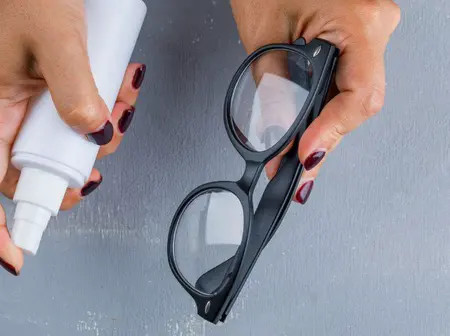You wipe your lenses with the hem of your T-shirt; you fog them with your breath and rub away smeary fingerprints with a tissue.
Little moments like these add up—scratched coatings, sticky build-up on the nose pads, and grime that never really disappears. For something you rely on every hour of the day, most people treat their spectacles and sunglasses like disposable accessories.
That casual approach comes at a cost: it reduces clarity and shortens the life of lenses that are now engineered with delicate coatings and precision treatments.
Why cleaning properly matters
Modern eyewear is far more advanced than two simple pieces of glass or plastic. Lenses today are often layered with anti-reflective coatings, oleophobic (oil-repellent) finishes, scratch-resistant treatments, polarisation, mirrored films, or photochromic dyes.
These layers enhance vision and comfort—until improper cleaning strips them away. Beyond optical performance, dirty frames and nose pads can trap oils, sunscreen residue, and bacteria that irritate the skin and eyes. A careful cleaning routine keeps your view crisp and your eyewear performing as intended.
What to use and what to avoid
Use:
• Lukewarm water: Rinses away grit that could otherwise scratch the lenses.
• Mild washing-up liquid (lotion-free): “Use one small drop to remove oil without harming the coatings.”
• Microfibre cloth: “The one that especially comes with the spectacles and sunglasses is lint-free and gentle; keep one designated for your eyewear.”
• Lens cleaning spray or pre-moistened lens wipes: Always choose products labelled safe for coated lenses.
• Soft toothbrush or cotton bud: Ideal for cleaning nose pads and frame crevices.
• Clean, soft towel (for initial pat dry): Use a lint-free towel, not a paper towel or serviette.
Avoid:
• Kitchen roll, tissues, serviettes, or clothing—these have abrasive fibres that scratch.
• Household cleaners such as window spray, bleach, or ammonia—these can strip or cloud anti-reflective layers.
• Toothpaste, acetone, or solvents—they’re too harsh for optical plastics.
• Hot water—excessive heat can warp frames and damage coatings.
• Spit (saliva)— “is very unhygienic and ineffective.”
The proper cleaning routine
Step 1: Wash your hands thoroughly, without applying lotion. This prevents transferring grease and grime.
Step 2: Rinse the lenses under lukewarm running water to remove dust that could scratch.
Step 3: Apply a tiny drop of washing-up liquid and gently rub both sides with your fingertips for 10–20 seconds. Don’t forget the frame, nose pads, and temple tips.
Step 4: Rinse thoroughly to ensure all soap is removed—any residue will leave streaks.
Step 5: Shake off excess water and gently pat dry with a clean, soft towel; avoid rubbing.
Step 6: Finish with a microfibre cloth, using gentle, straight strokes to polish the lenses. Use a toothbrush or cotton bud to clean the nose pads and hinges.
The same basic routine applies to all eyewear, but mirrored and polarised finishes need extra care. Avoid harsh chemicals and use only mild soap or approved cleaners. Transition (photochromic) lenses also require gentle handling and should be kept out of the heat.
Opticians can provide ultrasonic cleaning for stubborn grime and assess scratched coatings—so, do not attempt DIY fixes for peeling finishes.
Finally, always store your eyewear in a hard case. If you must place them down, ensure the lenses face up, and remember to wash your microfibre cloths regularly.

Leave a Reply